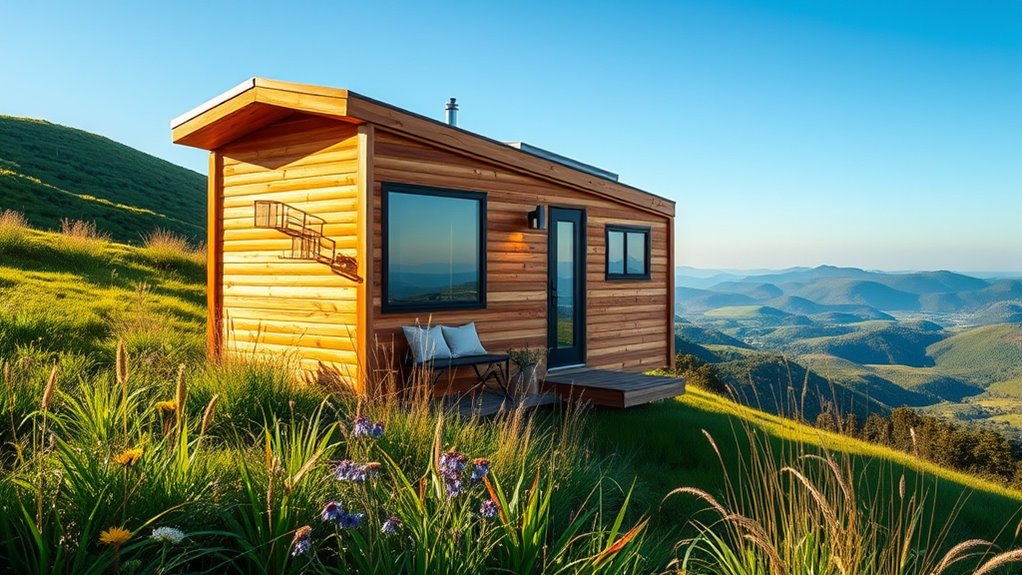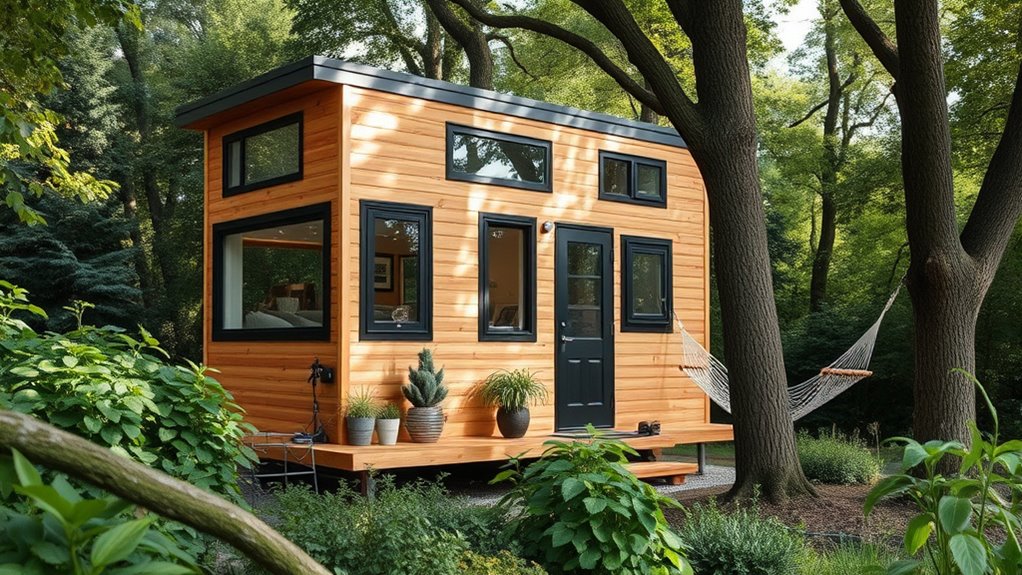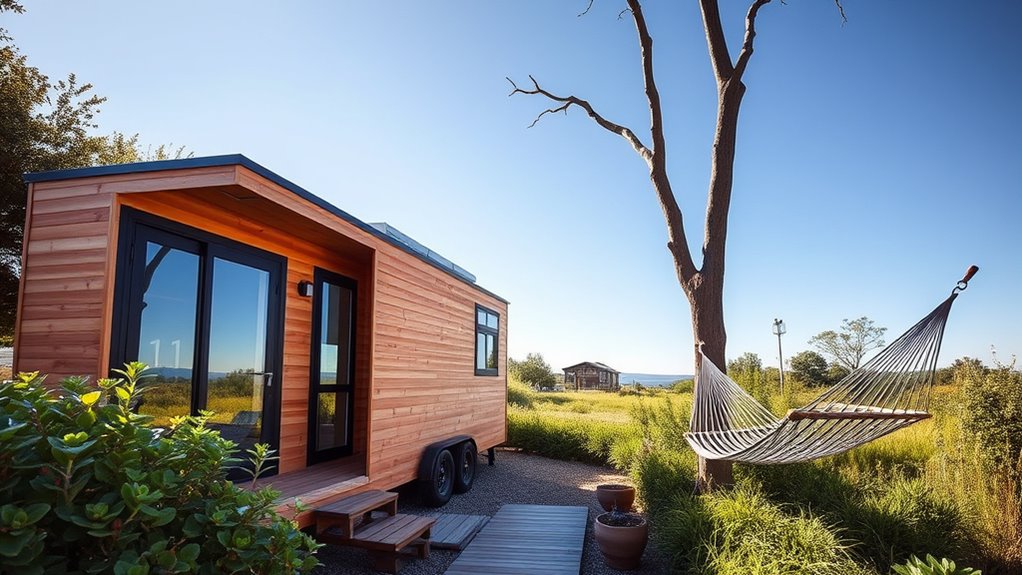The tiny house trend grew from early minimalist experiments into a mainstream lifestyle by focusing on sustainability, affordability, and intentional living. Society’s shift toward eco-friendly choices and simple aesthetics fuels this movement, while clever design innovations maximize small spaces. Embracing tiny living brings benefits like lower costs and less clutter, though it also has challenges. If you want to explore how this movement continues to reshape housing options and cultural values, there’s more to discover ahead.
Key Takeaways
- The movement evolved from niche experiments into mainstream options through increased focus on sustainability, affordability, and minimalist lifestyles.
- Cultural shifts toward eco-consciousness and intentional living fueled broader acceptance of tiny houses.
- Innovative design trends, like multi-purpose furniture and space-saving solutions, made tiny living more practical and appealing.
- Benefits such as lower costs and environmental impact, alongside challenges like limited space, helped shape public interest.
- Technological advancements and urban sustainability initiatives are driving the movement’s future growth and mainstream integration.
The Origins and Evolution of Tiny Living

The concept of tiny living has roots that reach back several decades, but it gained significant momentum in the early 2000s as people sought more sustainable and affordable lifestyles. You might find that embracing a minimalist lifestyle became a key part of this movement, focusing on reducing clutter and prioritizing what truly matters. Tiny houses represent a shift towards sustainable living by minimizing environmental impact and decreasing resource consumption. Early pioneers began designing small spaces that emphasized function and simplicity, inspiring others to reconsider traditional housing norms. Over time, this movement evolved from niche experiments to mainstream options, driven by a desire for financial freedom, ecological responsibility, and a more intentional way of living. Today, tiny living continues to grow, reflecting broader cultural shifts toward sustainability and minimalism.
Cultural Shifts Driving Tiny House Popularity

As society increasingly values sustainability and intentional living, these cultural shifts have fueled the rise of tiny houses. People now prioritize eco friendly materials to reduce environmental impact, making tiny homes more appealing. The minimalist aesthetics of tiny houses resonate with those seeking simplicity and clarity in their lives. This movement reflects a desire to downsize unnecessary possessions and focus on what truly matters. The emphasis on sustainable practices and streamlined living aligns with broader societal concerns about climate change and resource conservation. Additionally, the use of sound vibrations in related wellness practices highlights a growing interest in holistic and mindful lifestyles. As a result, tiny houses symbolize not just affordable housing, but a lifestyle rooted in environmental responsibility and mindfulness. These cultural values have transformed tiny houses from niche experiments into mainstream choices for individuals seeking a more meaningful, eco-conscious way of life.
Design Trends and Innovations in Small Spaces

Innovative design trends are transforming small spaces into functional, stylish living environments. You’ll notice the rise of portable furniture that easily folds or stacks, maximizing every inch of your tiny home. These pieces let you adapt your space quickly, whether you’re hosting guests or creating a different vibe. Minimalist decor also plays a key role, helping you keep clutter at bay and maintain a clean, open feel. With sleek lines, neutral tones, and strategic storage solutions, your tiny house can feel spacious and inviting. Smart design choices focus on multi-purpose furniture, wall-mounted storage, and clever layouts to optimize limited square footage. As these trends evolve, they empower you to enjoy comfort and style without sacrificing functionality in your small space. Incorporating effective space-saving ingredients can further enhance your home’s efficiency and aesthetic appeal.
Benefits and Challenges of Embracing Tiny Living

Embracing tiny living offers a range of compelling benefits that can enhance your lifestyle, from reduced expenses to a smaller environmental footprint. With better space efficiency, you’re encouraged to prioritize what’s truly important, fostering a minimalist lifestyle that reduces clutter and stress. However, challenges exist, like limited space for belongings and privacy concerns, which require creative solutions. You may also face zoning restrictions or difficulties hosting guests comfortably. Despite these hurdles, many find the simplicity and intentional living rewarding. For instance, selecting appropriately sized home theatre projectors can enhance entertainment without sacrificing space.
The Future of the Tiny House Movement

The future of the tiny house movement looks promising as more people seek sustainable, affordable, and simplified living options. Urban sustainability becomes a key focus as tiny homes support eco-friendly lifestyles and reduce environmental impact. With space limitations, you’ll embrace minimalist philosophy, prioritizing quality over quantity and decluttering your life. As cities grow denser, tiny houses offer flexible solutions for affordable housing and community integration. Innovative designs and regulations are evolving to make tiny living more accessible and practical. Technology advancements will continue to enhance comfort and energy efficiency in small spaces. For example, integration with renewable energy solutions like solar panels and efficient insulation can significantly reduce energy consumption in tiny homes. Overall, the movement is poised to influence broader housing trends, encouraging a shift toward mindful, sustainable living that aligns with future urban development goals.
Frequently Asked Questions
How Do Tiny Houses Impact Local Zoning Laws?
You might face zoning challenges and legal restrictions when building tiny houses, as local laws often aren’t designed for such small structures. These regulations can limit where you can park or build, making it harder to realize your tiny house dreams. To overcome this, you’ll need to work with local authorities, advocate for zoning changes, and stay informed about specific rules that impact tiny house placement and legality.
What Are the Most Common Materials Used in Tiny House Construction?
Think of tiny house materials as the building blocks of your dream home. You’ll likely use sustainable materials like reclaimed wood, bamboo, and recycled metal to minimize environmental impact. Innovative designs often incorporate lightweight siding, spray foam insulation, and durable flooring choices like cork or laminate. These materials help maximize space and efficiency, turning a small space into a cozy, eco-friendly retreat where every detail counts, just like the story of someone transforming a shed into a charming tiny home.
How Do Tiny House Communities Foster Social Interaction?
You can see tiny house communities foster social interaction through community bonding activities and shared amenities. By living close, residents naturally connect during communal meals, events, or yard work. Shared spaces like gardens, laundry facilities, and gathering areas encourage conversations and friendships. This setup creates a supportive environment where neighbors become friends, making social interaction a seamless part of daily life and strengthening the sense of belonging within the community.
What Financial Incentives Are Available for Tiny House Buyers?
Thinking about buying a tiny house is like finding a hidden treasure chest. You can access various financial incentives, such as tax benefits and potential grants, which make the investment more affordable. Some states offer property tax exemptions or deductions for tiny home owners. Additionally, you might qualify for special loans or financing options designed for small, eco-friendly dwellings, helping you save money and enjoy your new home even more.
How Does Tiny Living Affect Long-Term Mental Health?
Living tiny can positively impact your long-term mental well-being by reducing clutter and financial stress. With less space to manage, you’ll experience less stress and feel more in control of your environment. This simplicity fosters mindfulness and contentment, leading to better overall mental health. Embracing tiny living encourages you to focus on what truly matters, helping you maintain lasting stress reduction and a healthier, happier mindset over time.
Conclusion
As you plunge into the tiny house trend, you’re stepping into a revolution that’s transforming dreams into reality so vast, they could fill an entire universe. Imagine living in a space so smart and stylish, it makes mansions look outdated. This movement isn’t just a phase—it’s a tidal wave reshaping how you see freedom, simplicity, and innovation. Embrace it now, because tiny living isn’t just a trend; it’s the future’s grandest, most exhilarating adventure!









